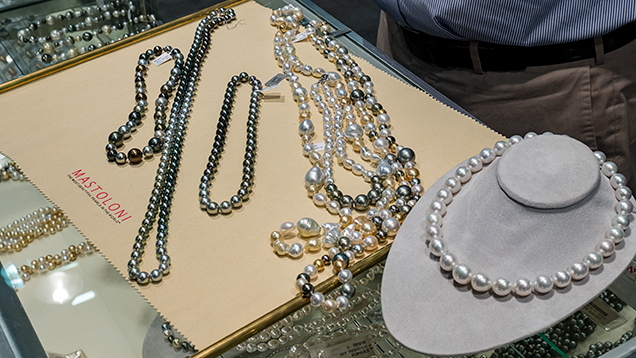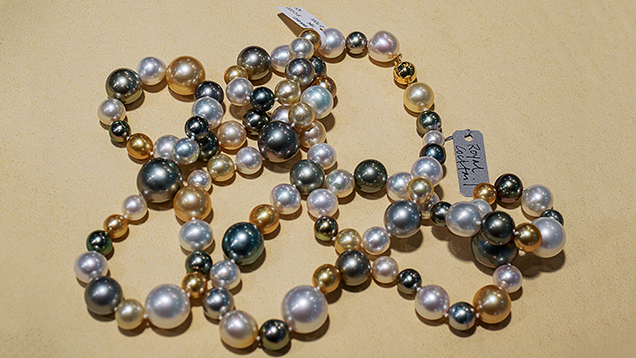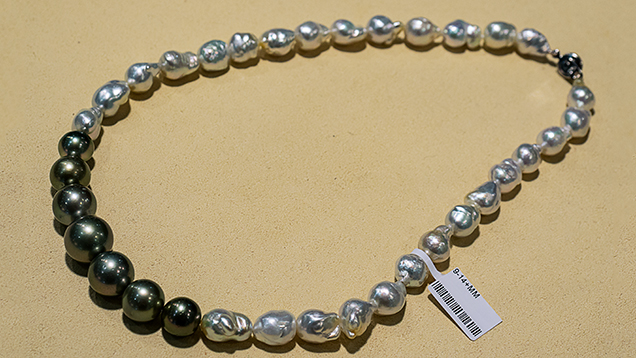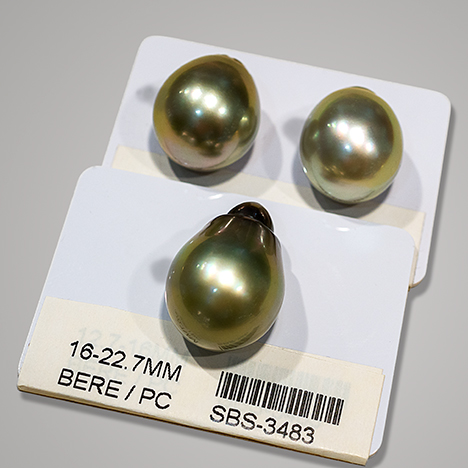Cultured Pearl Market Update

At the 2017 AGTA show, Fran Mastoloni (Mastoloni Pearls, New York City) provided a cultured pearl market update. Mastoloni is a 30-year veteran of the Tucson show and well positioned to place the ups and downs of demand in context. There is a real desire for cultured pearls, he says, but people have moved away from the traditional white necklace. Partly this is because cultured pearl sources have become much more diverse in recent years, with French Polynesia, Australia, the Philippines, Indonesia, and China contributing a diverse array of cultured pearl types, shapes, sizes, and colors (figure 1).
Mastoloni’s clients are seeking—and selecting—something different. “They all want a unique necklace,” he says. And since the second quarter of 2016, he’s seen demand pick up considerably. Most clients don’t want to spend a fortune, but they do want the piece they choose to be unique and individual. His job is to create cultured pearl necklaces that meet their needs.
To demonstrate, Mastoloni showed us his “Fantasy” necklace: a standard-length strand combining South Sea and Tahitian cultured pearls with lighter gold ones from Indonesia. This blends a repeating pattern of large (up to 16 mm) eye-catching, semi-baroque pearls with smaller examples—down to 8 mm—to create a large, mixed look. The use of light and dark pearls also confers the ability to use the piece on a variety of clothing colors for day or night use, he added, so it’s very versatile. He added that products must also appeal to female self-purchasers, so the retail price point—less than $2,000 per strand—is an important consideration. This is a very important—if not the most important—market segment for him today.
Mastoloni showed us another successful cultured pearl line for the company, which he dubbed the “Cocktail” necklace (figure 2). It combines Philippine gold pearls, white Australian South Sea, and lighter Tahitian pearls to create a long necklace that can be draped twice. Again, every necklace is individual, so that a customer can “key into” an individual pearl—maybe a large South Sea or Tahitian—and identify that necklace as unique. Examples like these, he explained, transform the concept of what a cultured pearl necklace might be.

Customers are similarly drawn to baroque pearls for their uniqueness. Mastoloni used a variation of the “Cocktail” necklace to illustrate the point, this time with baroque pearls ranging from 16–17 mm plus down to 9 mm. The organic shapes bring texture and movement to the piece and “make it fun.”

The next necklace he showed us blended 9 mm baroque white South Sea “keshi” pearls with 14 mm dark Tahitian round cultured pearls, creating two transitions: from light to dark and from organic shapes to regular, round ones (figure 3). A customer might own all three of these necklaces, he said, and use them for different occasions.
Also popular are variations on the wave necklace, which blends a uniform strand of round white Japanese akoya cultured pearls with “waves” of graduated silvery black Tahitian cultured pearls that swell and pinch out against the white of the akoyas. The mix of the different cultured pearl types working together is what makes these designs so successful. They’re the kind of “fashion-forward” pieces that stylish but price-conscious consumers pick out, he says.
Of course, sourcing pearls for all these necklaces is always a challenge for Mastoloni. One of his key considerations is maintaining standards. For the “Cocktail” necklaces he has to source pearls of the same tone, color saturation, and luster. You just can’t throw pearls together and expect them to look good, he explained. It requires an understanding of the product along with consistency in both quality and look—as well as an enormous amount of pearls.
Mastoloni asked us to look at professional women of power on television, who frequently wear significant pearl necklaces. Their choice might be a necklace combining different pearl colors, or a uniform one with large round white South Sea or Tahitian cultured pearls. Fine pearls can be worn in the boardroom or at social gatherings—they show that the wearer “has arrived.” No other jewelry is as versatile.
Mastoloni noted that the supply of Tahitian cultured pearls has changed. Although there looks to be a good variety of subtle colors, he’s not seeing the same wide range of colors as 10–15 years ago. This appears to be because the culturing process is improving and there is more control over color consistency. This is better from the point of view of investors, because consistent colored pearls are easier to match and sell. As a result, those investing in pearl cultivation find it easier to recoup their expenses.
Next, he showed us single pearls and collection pieces, starting with a 23.3 × 28.6 mm Australian baroque South Sea pearl that was solid and unblemished on all its surfaces. Single pearls like this one are unique items that a person can make their signature piece—something they wear every day.
Pairs, such as the 15.0 × 18.5 mm Tahitian cultured pearls seen in figure 4, are also perfect for unique pieces. Their light pistachio color is one of the colors Mastoloni used to love but can no longer easily obtain. Serendipitously, he found a matching-color larger drop shape measuring 16.0 × 22.7 mm to make up a trio (again, see figure 4). According to Mastoloni, the right designer could make an incredible piece out of these.

His next piece was a 16 × 23 mm Tahitian drop pearl with a unusual shape and excellent luster. It was a near-perfect teardrop with a very attractive slightly asymmetrical tip, shaped almost like a drop of water. It begs attention, he explains, a pearl like this could be the center of attention in a one-of-a-kind necklace. Mastoloni confirmed that such teardrop-shaped pearls are now difficult to find in Tahitian production. As pearl culturing techniques improve, drop pearls are nowhere near as desirable—or as profitable to produce—as spherical ones. Pearl farmers are more concerned with return on investment, so they are really striving to produce more round pearls. As pearl culturing methods improve, consequently, it becomes harder and harder to find nice teardrops—producers make a lot of less attractive, misshapen examples which bring down the value of the harvest.
Finally, Mastoloni showed us a top-quality pair of 15.3 mm round golden pearls. He noted that golden pearls—which are generally produced from the gold-lipped oyster in the Philippines and Indonesia—are still a good business, with much stronger demand in Asia than in the U.S., although the market probably peaked about a year ago. He notes that there might be a little oversupply in Asian markets, but he expects it to be temporary. As far as quality is concerned, Mastoloni’s advice is to look for a pearl that has a good “gold” color—he always likens it to a “ring color”—“you don’t want yellow and you don’t want green, but it’s got to have a richer gold to it,” he says. Indonesia is always going to have a steady supply of pearls, because cultivation takes place over such a large area, he says but cautions that there’s so much champagne and creamy greenish yellow production that he cannot use. He notes that their supply is getting better, but it’s not quite there yet. In his opinion, cultivators in the Philippines are excellent at producing gold pearls, as their waters and their oysters are better suited for these products. Indonesia will continue to produce all colors, and Australian pearl farmers will concentrate on white, while those in Tahiti focus on the different shades and nuances of black pearls.



